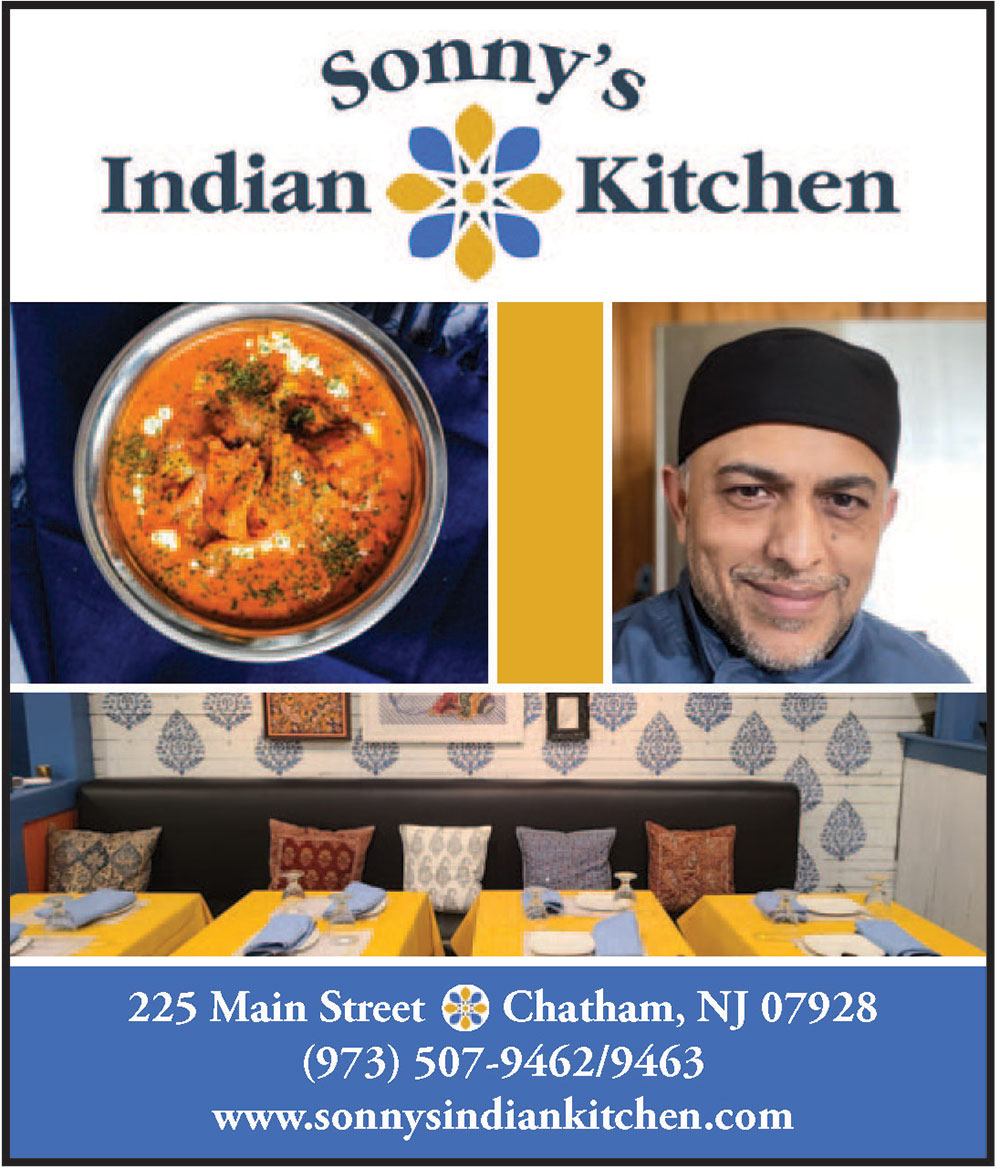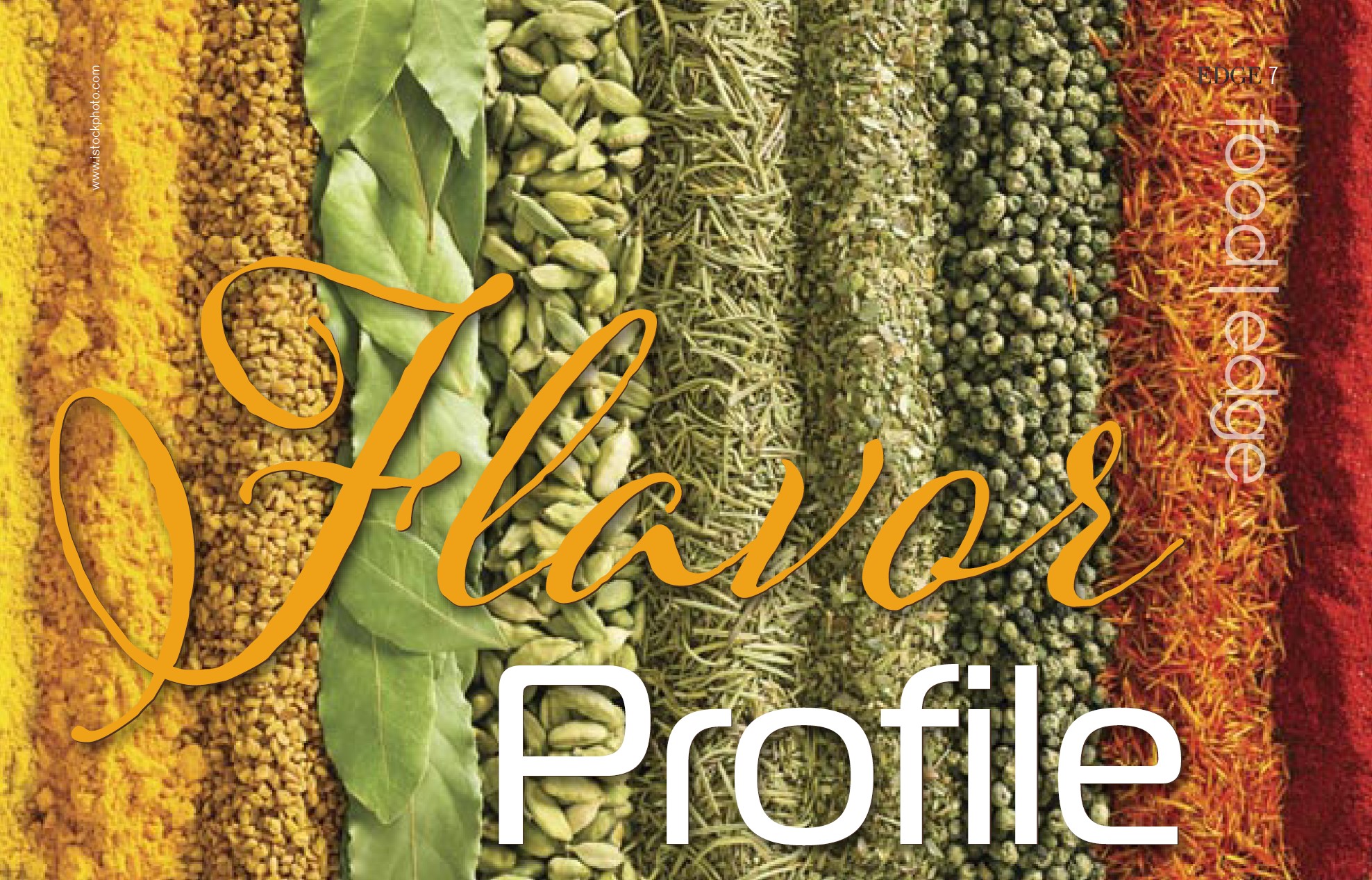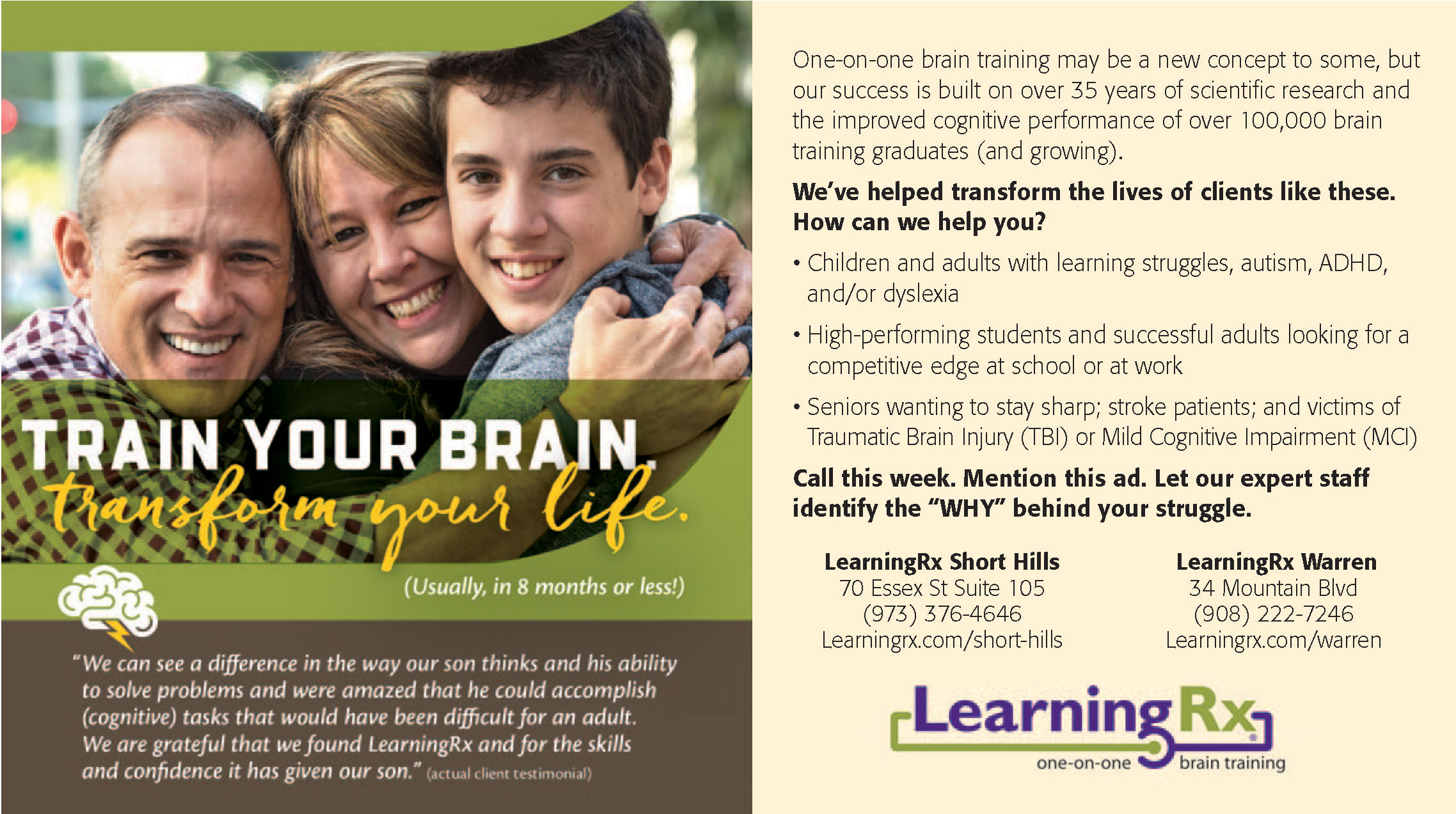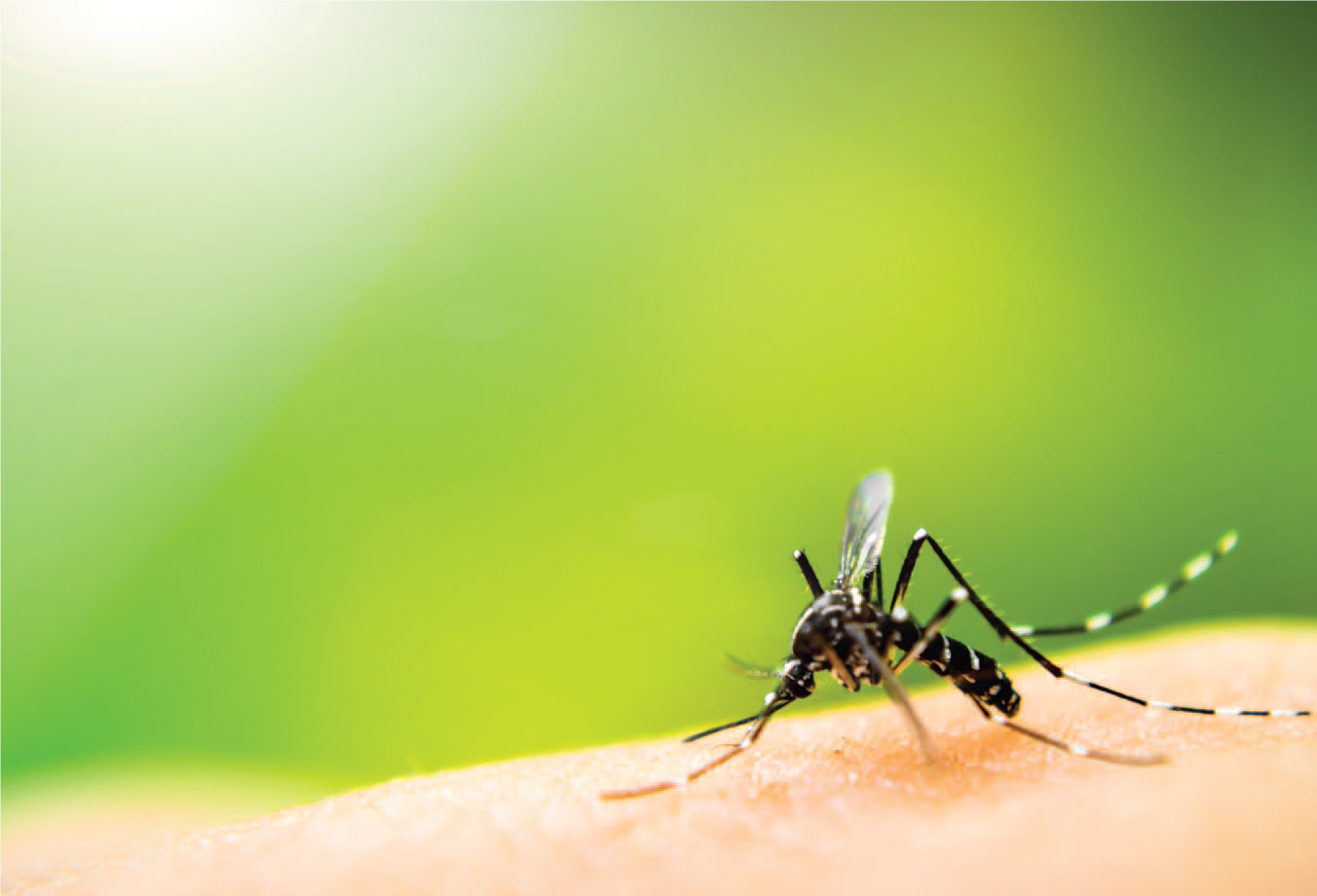There’s a lot going on in Indian curry dishes… but maybe not as much as you think.
Indian food is difficult to cook unless you own an Indian restaurant. In places like New Jersey, where this cuisine has become increasingly popular, even the most intrepid diners still operate under this assumption. Home chefs who have mastered the intricacies of Vietnamese Pho, Thai stir fry, Jamaican jerk chicken and Brazilian barbecue not only tend to be intimidated by the thought of diving into Indian curry, they find the thought of navigating their way through the aisles of places like Patel Brothers utterly terrifying.
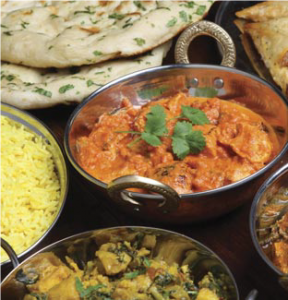
www.istockphoto.com
Granted, if you’re new to cooking Indian curries at home, you might feel a little overwhelmed. Curry is all about subtlety and complexity, after all. But once you stop to take it all in and begin to learn the differences in the food of the wonderful country of India, things will start to fall into place. Your journey into Indian cuisine will be easy and enjoyable, and change any preconceived ideas that Indian food is difficult to cook.
With 29 states and seven union territories, it is said that the language and food of India changes every 50 miles as you travel the subcontinent. Each state has its own regional specialties, and then there are sub-cuisines that reflect religion, caste, the climate and availability of local ingredients. For example, a lentil stew called sambar—known throughout the country’s southern states—will be made slightly differently wherever you visit.
Not surprisingly, everyone claims that their version is the best. Sound familiar?
It would be impossible to put all the curries of India in a single book. Great tomes have been written, and still none can be considered truly comprehensive; such is the nature of a cuisine that caters to almost 1.4 billion people—and where the ingredients used in a dish can change from village to village and even household to household (all without recipes to guide them!). It is testament to Indians’ love of food that a recipe will be refined and perfected over time to suit personal tastes: a little more spice here, a different vegetable there, and then passed down through the generations to create family favorites.
Despite these subtle differences, there are, of course, popular dishes that everyone cooks and for which India is famous, and last year I collected 50 of the best (and easiest) vegan, vegetarian and non-vegetarian recipes to make from scratch in 50 Easy Indian Curries. I also included simple instructions for pastes, rice and breads to complete an Indian meal. With a few essential Indian pantry staples and fresh ingredients—all of which can be found at any decent supermarket—each curry can be made in an hour or less, or thrown into a saucepan and left to slow cook on the stove while you get on with something else. The keys are ease and speed (plus some fun shopping adventures).
Make A List

www.istockphoto.com
On your next trip down the GSP to Patel’s (or another of New Jersey’s growing number of South Asian supermarkets), bring this list along. It’s what you’ll need to stock your “Indian Pantry” and execute every curry recipe in this article.
Asafoetida • Pure asafoetida (or heeng) has a strong, almost off-putting smell that dissipates when cooked and is used as a substitute for garlic and onions by Indians who avoid these ingredients. Just a pinch of asafoetida is enough to flavor a dish. You will find it in small plastic containers, diluted with rice or wheat flour to dull down the pungent smell.
Cardamom • Cardamom is a perfumed spice that is much loved throughout India. It is equally at home in baked treats and confections as in curries. You’ll notice the recipes in this story and in my book use both green and black cardamom pods, so buy both.
Chillies • Indian food is almost incomplete without chillies yet, ironically, the chilli plant is foreign to India—arriving with the Portuguese in the 15th century. Indian cuisine uses green and red fresh chillies, along with chilli powder, the most famous of which comes from Kashmir.
Cinnamon • Whereas cinnamon is often reserved for baking in the U.S., in India it is part of a collection of whole spices that are added to curries. Often confused with cassia—which comes from China and has a slight amount of heat—real cinnamon only grows in Sri Lanka.
Cloves • Cloves, which are not native to India, have a strong, astringent flavor profile and should be used sparingly in dishes.
Coriander • Coriander seeds are used extensively in Indian cuisine for their warm, nutty flavor. Lightly toasted, they become even more fragrant and, when powdered, they tone down other strong flavors, such as chilli. Coriander leaves (aka cilantro) are commonly added as a garnish and never cooked in order to retain their vibrant green color.
Fenugreek • The whole seeds are used as a tempering in dals, as well as being added to Indian pickles. Fresh fenugreek leaves are used extensively in cooking and their dried form—known as kasuri methi—is sprinkled on top of cooked dishes for its aromatic quality. It’s a true wonder spice.
Garam Masala • A powdery blend that roughly translates to “hot spice,” it actually doesn’t contain much heat. It is made by dry-roasting different types and quantities of spices and then blending them together. Garam masala is typically added at the end of cooking, the purpose being to add aroma and flavor, without overpowering the final dish.
Turmeric • Indian kitchens would be colorless without this wonderful spice. Known not just for its culinary use but also for medicinal and antiseptic qualities, turmeric is also the only spice that Hindus use for devotional purposes. The active ingredient in turmeric is curcumin, which is known for its healing properties. Once you gain confidence, you may even find yourself adding your own twists and flourishes. Indian food, after all, is more than an explosion of flavors, colors and spices. Like all the great world cuisines, it is a form of personal expression. Here are a half-dozen relatively simple curry dishes—each serving four—that you can make in your own kitchen and, ultimately, make your own…

Eggplant Masala
Eggplant is a popular ingredient in Indian cuisine. Roasted, grilled or fried, it adds a “meatiness” to vegetarian curries. This eggplant masala is simple and quick to make and goes perfectly with other curries. The yogurt adds a delightful fresh touch.
You’ll need…
2 large (about 2 lb.) eggplants (aubergines), cut into (3/4”) chunks
1/2 teaspoon sea salt
2 tablespoons ghee or vegetable oil
1 teaspoon black mustard seeds
3 Asian shallots, sliced
2 (3/4”) pieces of ginger, finely grated
2 garlic cloves, thinly sliced
1 long red chilli, chopped
14 oz. canned crushed tomatoes
1/2 teaspoon ground cinnamon
1/4 teaspoon ground cardamom
pinch of ground cloves
1/4 cup of natural yogurt
Cilantro and papadam (Papadam is a deep-fried crunchy dough that can be purchased pre-packaged or made at home.)
Place the eggplant in a large bowl and sprinkle with the salt. Toss to combine and set aside for 30 minutes. Rinse well and pat dry with paper towel. Heat a large heavy-based non-stick frying pan over high heat. Working in batches if necessary, add the eggplant to the dry pan and cook, stirring occasionally, for 5-6 minutes per batch, until lightly browned all over. Transfer to a plate and set aside. Heat the ghee or oil in the same frying pan over medium-high heat. Add the mustard seeds and sizzle for a few seconds. When the seeds start to crackle, add the shallot, ginger, garlic and chilli. Reduce the heat to medium and cook for 4-5 minutes, stirring occasionally, until the onion is golden. Add the tomatoes, cinnamon, cardamom, cloves and 125 ml (1/2 cup) of water and return the eggplant to the pan.
Cover and cook, stirring occasionally, for 10-15 minutes, until the eggplant is very tender and the sauce has thickened slightly. Season with a little salt, if necessary. Spoon the yogurt over the curry, garnish with coriander leaves and serve with papadams on the side.
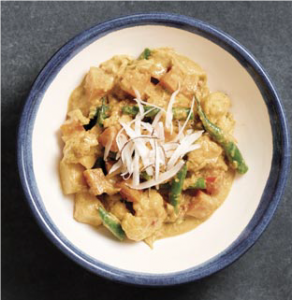
Goan-Style Vegetable Curry
The state of Goa on the southwestern coast of India is known for its delicious fish curries, beer and a very chilled-out approach to life. But Goa also has many vegetarian dishes in its culinary repertoire, and this vegetable curry is one of the best. Coconut grows abundantly in the region, and here it adds a subtle, creamy flavor that elevates the dish.
You’ll need…
2 tablespoons coconut oil or vegetable oil
10 oz. cauliflower florets
1 large potato, peeled and cut into 1/2” pieces
1 onion, chopped
1 tomato, finely chopped
1 tablespoon ginger and garlic paste
2 small green chillies, sliced
1/2 teaspoon ground cumin
1/2 teaspoon ground turmeric
8 fl. oz. coconut milk
1 large carrot, chopped
5-6 oz. green beans, trimmed and sliced
1/4 cup freshly grated coconut, plus extra to serve (You can also use frozen grated coconut, which can be purchased at most NJ grocery stores.)
1/2 teaspoon sea salt
A handful of cilantro, chopped, plus extra to serve
1-2 teaspoons tamarind purée, to taste
Steamed basmati rice
Heat a large frying pan over medium heat and add half the oil. Add the cauliflower and potato and sauté for 4-5 minutes, until lightly browned. Transfer to a plate and set aside. Add the remaining oil to the pan along with the onion and sauté for 5-6 minutes, until softened. Add the tomato and cook for 2 minutes or until softened, then add the ginger and garlic paste and cook until fragrant. Add the chilli and spices and cook, stirring, for a further 2 minutes or until fragrant.
Add the coconut milk, along with 1 cup of water, all the vegetables and the grated coconut, and bring to a boil over medium heat. Reduce the heat to a simmer, season with the salt and cook (covered) for 10-12 minutes, until the vegetables are tender. Stir in the chopped coriander and tamarind, to taste. Garnish with extra coriander and/or extra coconut and serve with steamed basmati rice.

Goan-Style Prawn Curry
Goans are particularly proud of their prawn curries and when you make this you’ll see why. The key to this dish is to ensure that the prawns are not overcooked. Served with lime wedges for extra zing. Like all of the dishes in this story, it serves four but be warned: Everyone will probably be going back for seconds.
You’ll need…
1 tablespoon peanut oil
1 onion, finely chopped
1 small tomato, finely chopped
1 tablespoon ginger and garlic paste
2 teaspoons sweet paprika
1 teaspoon ground coriander
1/2 teaspoon ground cumin
1/2 teaspoon freshly ground black pepper
1/2 teaspoon cayenne pepper
10 fl oz. coconut milk
2 lbs. raw prawns, peeled and deveined, with tails left intact
1/2 teaspoon sea salt
1-2 teaspoons tamarind purée, to taste
Cilantro for garnish
Steamed basmati rice
Lime wedges
Heat the oil in a large frying pan over medium heat. Add the onion and cook, stirring occasionally, for 6-8 minutes, until softened and starting to brown. Add the tomato and cook for 2 minutes, or until softened. Add the ginger and garlic paste and cook until fragrant.
Add the spices and cook, stirring, for a further 2 minutes.
Add the coconut milk and bring to a boil, then reduce the heat to a simmer and add the prawns, salt and tamarind purée. Stir and cook for 4-5 minutes, until the prawns are just cooked through. Scatter with coriander leaves and serve with steamed basmati rice and squeeze the lime over the entire dish.
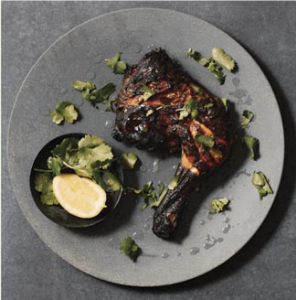
Tandoori Chicken
A tandoor is a clay oven set into the earth and fired with wood or charcoal. It can reach eye-watering temperatures of up to 900°F, allowing marinated meat to cook very quickly. Alas, not many of us have a tandoor in the backyard, but you can still rustle up a reasonable facsimile of this dish using a domestic oven. The trick is to spatchcock (aka butterfly) the chicken— a technique that will change your culinary life if you don’t know it already, even if you never cook a single Indian meal.
You’ll need…
Whole chicken, about 3 1/2 lb.
3/4 cup natural yogurt
1/2 cup Tandoori curry paste (see below)
Cilantro
Lemon wedges
1 package/4 pc. of naan
First, butterfly the chicken. Using kitchen scissors, cut along both sides of the backbone and remove. Turn the chicken over and place on a clean work surface. Using the heel of your hand, press down firmly on the breastbone to flatten. Score the chicken about 1/2 in. deep through the thickest parts of the breast, thighs and legs. Combine the yogurt and tandoori curry paste in a bowl, then rub all over the chicken, rubbing well into the scored areas. Transfer to a baking tray lined with baking paper, then cover and marinate in the fridge for 2-4 hours.
Preheat the oven to 465°F, using the convection option if you have it. Roast the chicken for 30 minutes or until it starts to char in spots. Reduce the oven temperature to 300°F and continue to roast the chicken for 5-10 minutes, until cooked through. Remove from the oven and set aside to rest, covered loosely with foil, for 10 minutes. Scatter the coriander over the chicken and serve with lemon wedges and naan on the side.
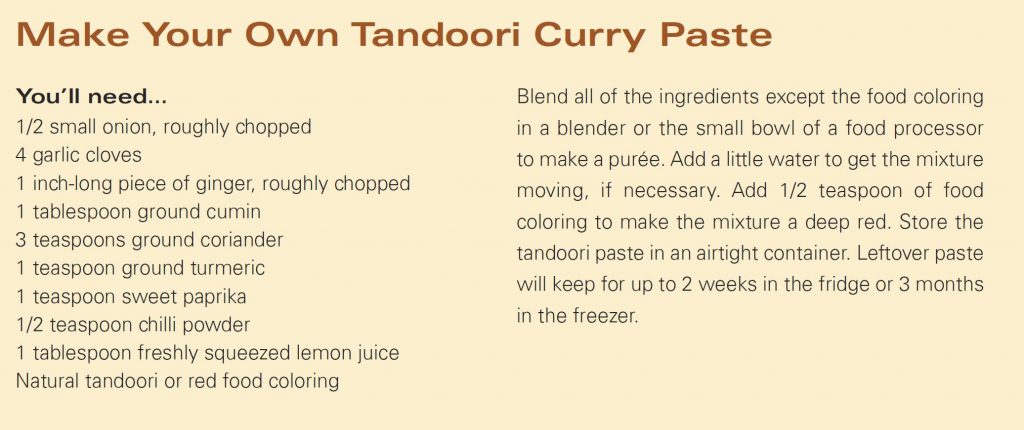
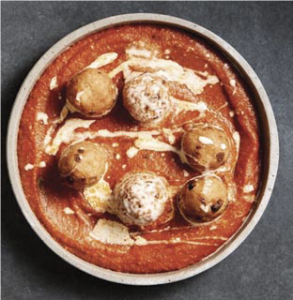
Malai Kofta
Everyone in New Jersey seems to have their own family recipe for meatballs. Well, since kofta is basically an Indian meatball, this may be your initial comfort zone. Malai kofta is an excellent dish to make when entertaining because it never fails to wow everyone. You can either serve the koftas on their own with the sauce on the side for dipping or stir the koftas through the curry at the end of cooking and serve with rice.
You’ll need…
14 oz. floury potatoes (low in moisture, high in starch)
Sea salt
1 cup grated paneer cheese (you can substitute tofu for vegans)
1 tablespoon finely chopped cashew nuts
1 tablespoon finely chopped raisins
3 tablespoons corn starch
1/2 teaspoon garam masala
1/2 teaspoon chilli powder (optional)
Vegetable oil for deep-frying
1/4 cup of cream
Steamed basmati rice
Malai kofta sauce…
1/3 cup of vegetable oil
1 onion, finely chopped
1 tablespoon ginger and garlic paste
2 cups puréed tomatoes
2 tablespoons cashew nuts, finely ground
1 teaspoon cumin seeds
1 teaspoon ground coriander
1/2 teaspoon ground turmeric
1 fresh or dried bay leaf
1 cinnamon stick
4 cloves
3 green cardamom pods, bruised
1/2 teaspoon dried fenugreek leaves, crushed
1/2 teaspoon garam masala
Peel the potatoes, then transfer to a saucepan, cover with cold water and add a good pinch of salt. Bring to a boil and cook until tender. Drain, then mash and set aside to cool. Combine the potato, paneer, cashews, raisins, corn starch, garam masala, chilli powder (if using) and 1/2 teaspoon of salt in a bowl. Knead the mixture into a soft dough, then divide into 12 portions and roll into smooth balls. Set aside.
To make the sauce, heat three-quarters of the oil in a frying pan over low heat. Add the onion and ginger and garlic paste and cook for 10 minutes. Add the tomato purée, ground cashews and 1 cup of water and simmer for 5-7 minutes, until slightly thickened. Season to taste with salt. Transfer this mixture to a food processor and blitz to a smooth sauce. Wipe the pan clean. Heat the remaining oil in the pan over medium heat and add the cumin seeds, ground coriander, turmeric, bay leaf, cinnamon stick, cloves and cardamom pods and cook, stirring, for 1 minute, until fragrant. Pour the sauce back into the pan and add the fenugreek leaves and garam masala. Gently warm through.
Back to the kofta…Heat enough oil for deep-frying in a saucepan to 375°F. Working in batches, deep-fry the kofta for 2-3 minutes, until well browned on all sides. Transfer to a plate lined with paper towel to drain, then gently stir through the sauce. Transfer the malai kofta to a serving dish and drizzle the cream over the top. Serve with the steamed basmati rice on the side.
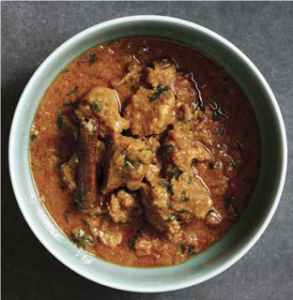
Lamb Rogan Josh
A famed dish from the beautiful state of Kashmir, the fiery red color of rogan josh comes from the chillies that are added in generous quantities. Rogan josh is usually cooked with tomatoes, but they are omitted here to allow the flavor of the lamb to shine through even more.
You’ll need…
2-plus lb. boneless lamb shoulder or leg, cut into 1” pieces
1 1/2 cups natural yogurt
1 teaspoon sea salt
2 oz. ghee (Indian clarified butter)
1 cinnamon stick
2 teaspoons green cardamom pods, bruised
4 brown or black cardamom pods, bruised
1/2 teaspoon cloves
3 onions, chopped
2 tablespoons ginger and garlic paste
1 tablespoon Kashmiri chilli powder
2 teaspoons sweet paprika
2 teaspoons ground turmeric
Large handful of chopped cilantro
1 teaspoon garam masala
4 pc. Paratha (Indian flatbread)
Combine the lamb, yogurt and 1/2 teaspoon of the salt in a large bowl. Cover and set aside to marinate. Heat the ghee in a heavy-based saucepan over medium heat. Add the cinnamon, cardamom pods and cloves and cook, stirring for 30 seconds or until fragrant. Add the onion and remaining salt, reduce the heat to medium–low and cook, stirring occasionally, for 20–25 minutes, until golden brown.
Add the ginger and garlic paste and cook, stirring for about 30 seconds, until fragrant. Add the lamb mixture, chilli powder, paprika and turmeric to the pan. Mix well and bring to a boil over medium heat. Reduce the heat to low and cook, covered, for 80 to 90 minutes, until the lamb is tender. Stir in the coriander and garam masala and season to taste. Serve with paratha on the side.
Editor’s Note: In her 50 Easy Indian Curries (Smith Street Books, $29.95), Penny Chawla covers restaurant classics—such as dal makhani, pork vindaloo and saag paneer—and lesser-known regional gems, including beef Madras and Bengali fish curry. “There is a curry here for everyone.” After watching Bend It Like Beckham, many wondered what was so special about making a “full Punjabi dinner.” Find this story at edgemagonline.com and look for bonus content that clears it all up!
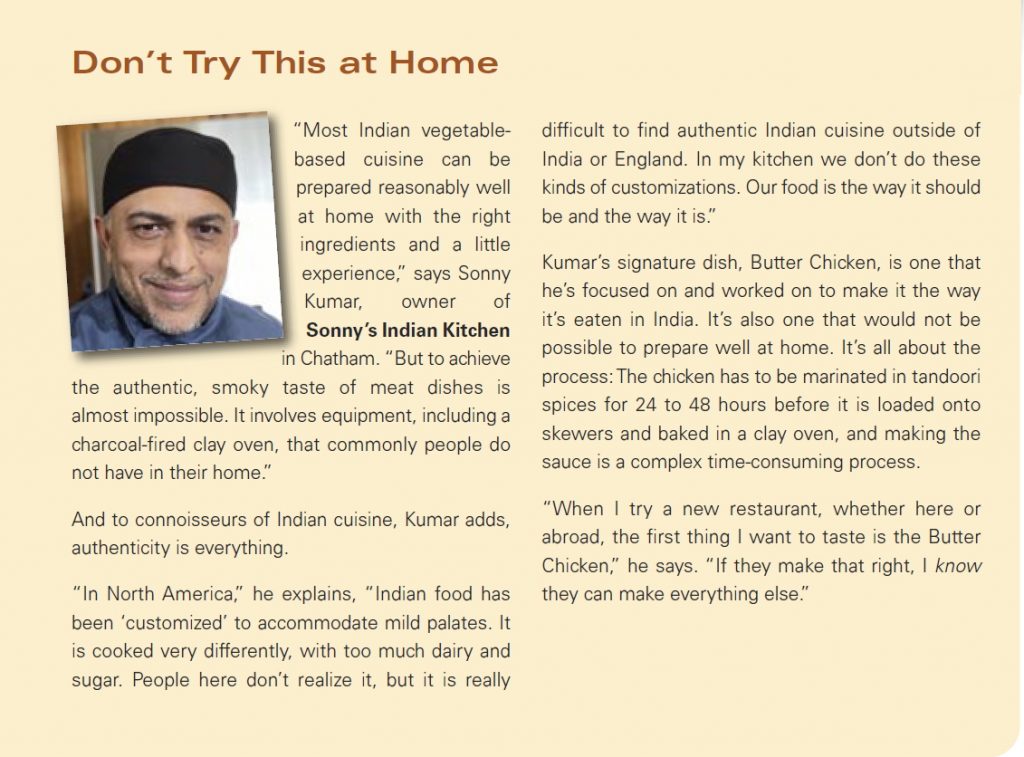
5 Minutes with…
Actor/Director Hugh Laurie
You have directed before, on House and other projects. Coming off of [Agatha Christie’s] Why Didn’t They Ask Evans? how do you assess yourself as a director at this point?

Upper Case Editorial
I’m not as calm as I would like to be [laughs]. I tended to become more agitated than I would have liked to have been. I think the problem is that any job you do in life is only difficult or easy in relation to how much you care about the outcome. Brain surgery is pretty easy…if you don’t mind the patient dying. But if you care a lot about something, things could be almost infinitely difficult or infinitely problematic, I should say. There will always be things that you wish—if only it could be this instead of that—and I confess that I was at times not as level-headed as I wish I could have been.
What are the most important qualities you need to be an actor, and what are the most important qualities you need to be a director?
Wow. I suspect the list of qualities you need to be a director may not be containable in a single person. You probably need seven people to do the job of a director in the way that it really ought to be done. It seems to me that the calls upon your judgment and time and energy and stamina are almost infinite. And the opportunity for making mistakes, likewise, is almost infinite. I think the similarity between acting and directing is that actors and directors need to be people who watch people. They need to watch people and know instantly what is true and what isn’t.
What got you started writing the adaption of Why Didn’t They Ask Evans?
It’s a murder mystery, but it has a kind of slight screwball feel to it. And one of the most remarkable things about it is that—and this I believe is unique for
Agatha Christie and maybe even unique for murder mysteries—the real mystery is not who the killer is. I mean, it is a mystery and we have to track that down, and he or she must be apprehended and brought before the law. But the real mystery is What does the question of the title mean? It’s like a 100-dimension Wordle where you’re trying to solve this puzzle and, until you solve it, it’s not really satisfying. You might catch the killer, but until you understand—until you decipher the question and answer the question—it doesn’t really satisfy. I think that is her genius.
Most of the clever repartee and witty dialogue in this series comes from the women characters. Do you agree…and did you have a part in that or was it all Dame Agatha?
I’ll make a confession now: Frankie Derwent, the heroine of Why Didn’t They Ask Evans? was my first- ever crush. I found her absolutely intoxicating. She’s quick and funny and bold and ready to take a chance. I just found her such good company. I was completely knocked over. And I do agree with you. The female characters, they’ve got some strong stuff. I would never in a million years dream of taking any credit. Along with the rest of us, I am just hanging on to the coattails— well, it wouldn’t be coattails—hanging on to the hem of the skirt of Dame Agatha for the ride.
Editor’s Note: Hugh Laurie adapted and directed Why Didn’t They Ask Evans?—a tale of two amateur detectives who get in over their heads investigating a murder—for a limited-run series debuting on BritBox this spring. For eight seasons, Laurie played the title role in the medical drama House, which was set in a New Jersey hospital and co-starred Lisa Edelman, who sat for a 2014 photo shoot and interview with EDGE. Lucy Allen of The Interview People, who interviewed Kristen Stewart in our last issue, conducted this Q&A.


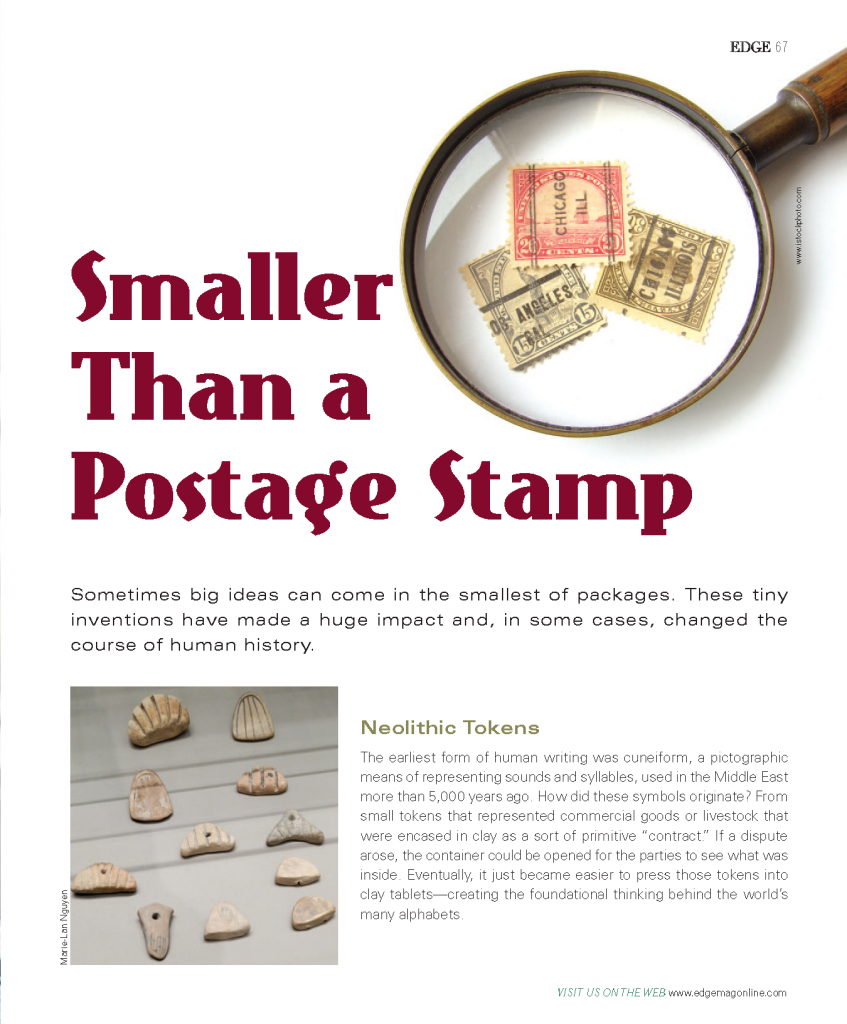


A Path Between EXTREMES
DBT treatment builds a life worth living.
By Christine Gibbs
May is Mental Health Awareness Month. It would not be an exaggeration to say that, thanks to the COVID pandemic, this May we are more aware than ever of the precarious state of our nation’s mental health. The National Institute of Health (NIH) has compiled a daunting set of statistics, including that one in five Americans today is living with at least one of a wide range of mental issues. That translates into more than 50 million people.

www.istockphoto.com
Not that COVID is the lone culprit. Pre-pandemic life was already a pressure cooker of high-stress triggers such as financial panic, job anxiety, inflation, debt— I could go on and on, but suffice it to say that life for almost everyone can be a challenge. However, burnout syndrome has certainly been exacerbated by COVID these past two-plus years and there has been a noticeable increase in the number of Americans suffering from depression and anxiety that can reliably be traced to COVID-specific restrictions, from lockdowns to mask mandates. That most definitely includes children, adolescents and emerging young adults who are exhibiting signs of depression in greater numbers as a result of forced isolation and remote education.
What is the actual degree to which we can attribute our elevated levels or incidences of stress and depression to the pandemic? That is endlessly debatable…and it also misses the point. If it feels as if you or a loved one is struggling emotionally—regardless of why—the more critical question is where should I look for help? Admitting that a problem exists, and recognizing that the situation has escalated to a point where managing it without help is no longer possible, is a critical first step. If you or someone close to you is exhibiting behavior that is concerning, harmful or uncontrollable, the time is now to seek help. Trinitas offers a full array of mental health support and services, providing almost 200,000 behavioral health outpatient visits a year.
One program that has enjoyed particular success is the Trinitas Institute for Dialectical Behavior Therapy and Allied Treatments—the DBT Institute, for short— which is headed by Co-Directors Atara Hiller, PsyD and Essie Larson, PhD. Dr. Hiller manages the Adolescent DBT Program, and Dr. Larson runs the Adult DBT Program.
“It Depends”

Atara Hiller, PsyD

Essie Larson, PhD
DBT is a type of cognitive behavioral therapy with the goal of building a life worth living by developing behavioral skills to improve impulse control, emotional regulation, interpersonal effectiveness and overall functioning, and replace old harmful ways of thinking and behaving with new, healthier ones. A fundamental principle of DBT treatment is finding “middle-of-the road” solutions to help overcome the extreme positions that interfere with adapting to real-life situations. In other words, for many of us, the concept of “it depends” is a fact of life—we recognize that the everyday decisions and situations we encounter are not binary, either/or, black-and-white, etc. For some people, however, this is extremely difficult to accept and tolerate. For them, the world is filled with battles between opposing forces of, for example, right and wrong or good and evil. Needless to say, it is an emotionally exhausting way to go through life.
When discussing the dialectical perspective, Dr. Hiller explains, “The key to successful adjustment may be accepting that the real truth is that there is no absolute truth at all. DBT accepts that two seemingly opposite truths can both exist at the same time, and that it is possible to modify behavior patterns to adopt a reasonable middle ground as a healthier response, instead of succumbing to either extreme position.”
“The reality that is encouraged is that there is no absolute truth, but rather everything is a mixed bag,” Dr. Larson adds.
The emphasis in DBT is placed on increasing emotional and behavioral regulation so that individuals can make effective choices that help them work towards their long-term goals. Clients undergoing this therapy are passionate about almost everything—and consequently are often judged as being irrational, attention-seeking, excessive or hot-headed because they react so quickly and take so long to cool down.
At the DBT Institute, these individuals are regarded as “exquisitely sensitive” and “super sensors.” The objective is to teach and encourage self-acceptance by validating their passionate internal experiences, while also guiding them to identify and change behaviors that interfere with reaching their personal goals. By providing a supportive, validating, and goal-oriented therapeutic environment, the team of DBT therapists helps the clients (and in the case of adolescents, their families as well) to learn and use the variety of skills taught in the treatment.
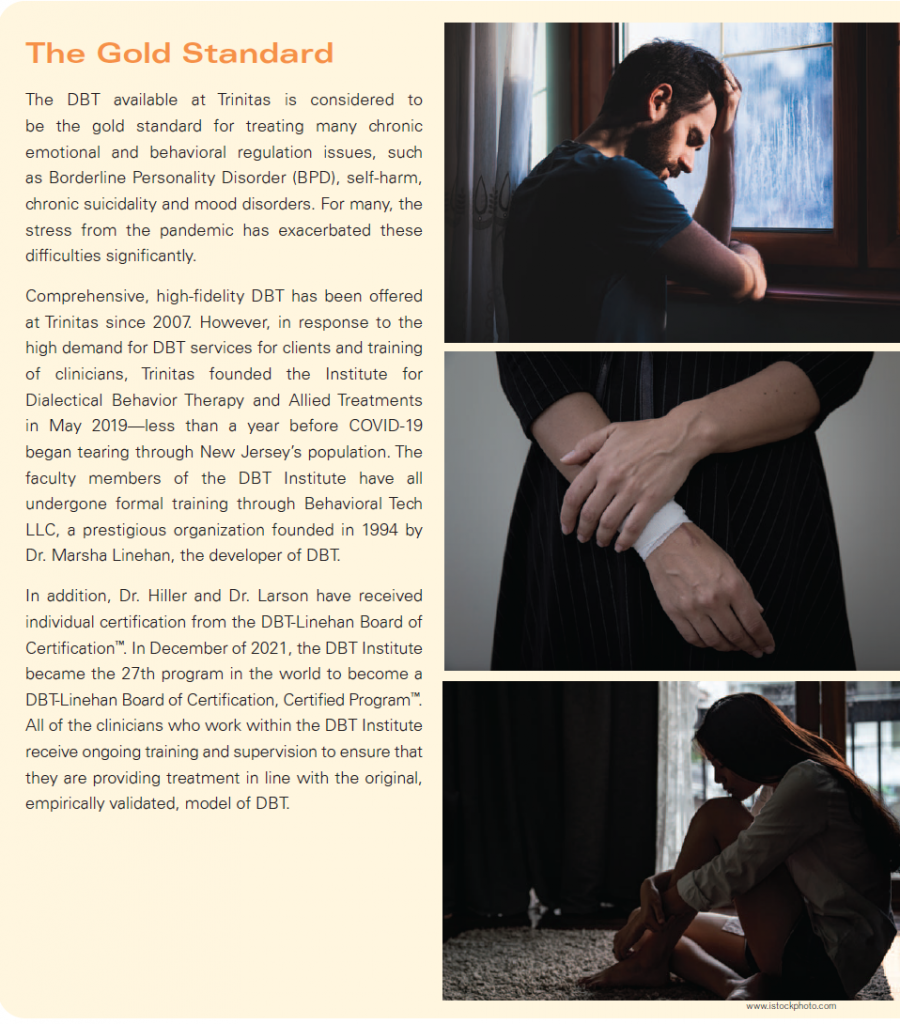 Getting Help
Getting Help
We all know family members, friends or co-workers who seem to be intractable in their views and behavior at times. However, individuals who benefit the most from DBT struggle with this at a much higher level of intensity. Typically, a DBT candidate presents as a person with challenges in multiple areas of life who has had previous unsuccessful experiences with other types of therapy. Behaviors such as self-harm, impulsivity, substance use, eating disorders and aggression become these individuals’ primary problem-solving methods to tolerate the debilitating emotional distress that they experience. Unfortunately, these behaviors seriously interfere with quality of life and social integration.
The objective of developing a healthy skillset is reflected in the DBT mantra: Build a life worth living! Comprehensive, outpatient DBT programs that follow the empirically based model are organized into three hours of weekly meetings—consisting of two hours of skills group (Adult DBT groups are for the clients only, while Adolescent DBT groups include parents/ caregivers) and one hour of individual therapy for the client. Between session, phone coaching is also available to help clients use their skills in their day-to-day lives. In addition, both the Adult and Adolescent programs offer services for graduates of the program to help them further solidify what they have learned. Across the Adult and Adolescent programs there are nine staff members, including Dr. Hiller and Dr. Larson. In addition, there are between 7 and 10 trainees at any given time. Several of the staff and trainees see both adult and adolescent DBT clients.
The adult DBT program requires an initial commitment of 52 weeks, followed by the opportunity to extend for another 26 weeks to complete two full cycles of the skills curriculum. The duration for one cycle of the curriculum for English-speaking adolescents/families is 20 weeks, whereas for Spanish-speaking adolescents/ families, the duration for one cycle of the curriculum is 24 weeks (because the groups are provided in both English and Spanish). Adolescent DBT requires that at least one parent/caregiver must also commit to the treatment by attending group and family sessions, and individual parent coaching sessions as needed. This is because having parents/caregivers support the use of DBT skills is essential. Clients in the Adult DBT program attend treatment alone with free monthly education nights provided for family members and friends who are interested in learning more about DBT treatment, DBT skills, and supporting their loved ones. All types of insurance are accepted. There is currently a substantial waiting list for both programs.
 During the pandemic, the Institute continued to serve clients through Zoom sessions. Despite an adjustment period, therapy quality was never compromised. Some clients (especially those living at a distance from Trinitas) found teletherapy to their liking, while others rejoiced when in-person therapy resumed. Most importantly, all of the DBT clients continued to make progress in the face of heightened stress and anxiety.
During the pandemic, the Institute continued to serve clients through Zoom sessions. Despite an adjustment period, therapy quality was never compromised. Some clients (especially those living at a distance from Trinitas) found teletherapy to their liking, while others rejoiced when in-person therapy resumed. Most importantly, all of the DBT clients continued to make progress in the face of heightened stress and anxiety.
“The skills we teach were the perfect tools to deal with uncertainty and major life changes,” says Dr. Larson.
Key Ingredient
Both Dr. Hiller and Dr. Larson emphasize that the indispensable component of successful completion of the DBT program is “commitment…commitment…and more commitment.” Clients must first believe, even if hesitantly, that their life can potentially improve and then they must be willing to put in the hard work—with the support and encouragement of their therapists—to start making it happen. “The foundation of any DBT program is that it is totally voluntary and therefore, by definition, requires an incredibly high degree of resolve,” Dr. Hiller explains. To be accepted into either the adult or adolescent programs, clients must sign a personal contract outlining the terms of their commitment.
 Modifying ingrained behavior patterns requires a whole-hearted dedication to achieving a balance between emotional extremes and learning how to identify and make more effective choices. Before being accepted, the DBT team spends time screening prospective clients on the telephone, followed by personal interviews to discern levels of motivation, increase commitment, troubleshoot potential issues and agree on a collaborative approach to reaching goals. The DBT program provides the tools and encouragement; the commitment to apply them to daily life is up to the client.
Modifying ingrained behavior patterns requires a whole-hearted dedication to achieving a balance between emotional extremes and learning how to identify and make more effective choices. Before being accepted, the DBT team spends time screening prospective clients on the telephone, followed by personal interviews to discern levels of motivation, increase commitment, troubleshoot potential issues and agree on a collaborative approach to reaching goals. The DBT program provides the tools and encouragement; the commitment to apply them to daily life is up to the client.
As a goal-oriented therapy, successfully completing what is referred to as Stage 1 DBT treatment in the Adult Program requires clients to demonstrate at the end of two cycles of the curriculum that they have moved closer to their goals by learning and applying the skills taught to them. In the Adolescent Program successfully completing Stage 1 DBT treatment may occur after one cycle, although most families stay for two cycles to solidify the improvements. Time limited graduate level treatment can be arranged for certain clients in both the Adult and Adolescent Programs, however Dr. Larson emphasizes that, compared to many other types of mental health therapy, DBT is meant to have a tangible end point. “DBT is a recovery-based model,” she says. “The goal is to get clients to the point where they no longer need therapy.”

Editor’s Note: The Trinitas Institute for DBT and Allied Treatments for adults is located at 654 East Jersey Street in Elizabeth (908) 994-7087. Adolescent DBT treatment is located at 655 East Jersey Street (908) 994–7378 (English) and (908) 994–7589 (Spanish). For more information, visit dbtnj.org. The Institute also offers a variety of training, supervision and consultation services to support clinicians interested in learning DBT or to hone their DBT therapy skills. Clinicians who are still in school or already licensed may apply to formally join the DBT Institute teams for comprehensive training. Applications can be found on the website.
A change of environment can transform the world of a master painter, photographer and art conservator. Villo Varga revealed her penchant for messages all over New York City. Born in Budapest, Hungary she defected in 1983, having garnered hefty experience, studying with Professor Erno Fischer at the Academy of Fine Arts and the Museum Restorers’ Methodology Center, working as conservator of the Hungarian National Gallery, and working as professional photographer. But in America, her artwork turned to ever-changing urban “messages” and images not to be lost forever.


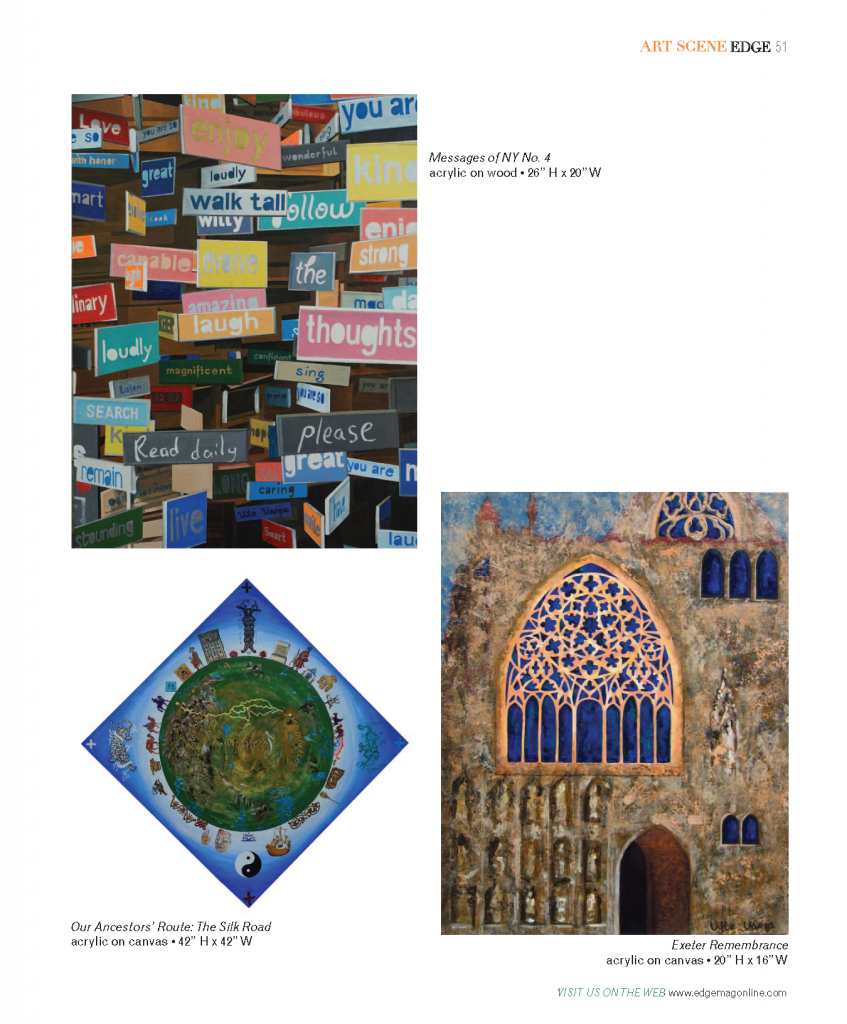
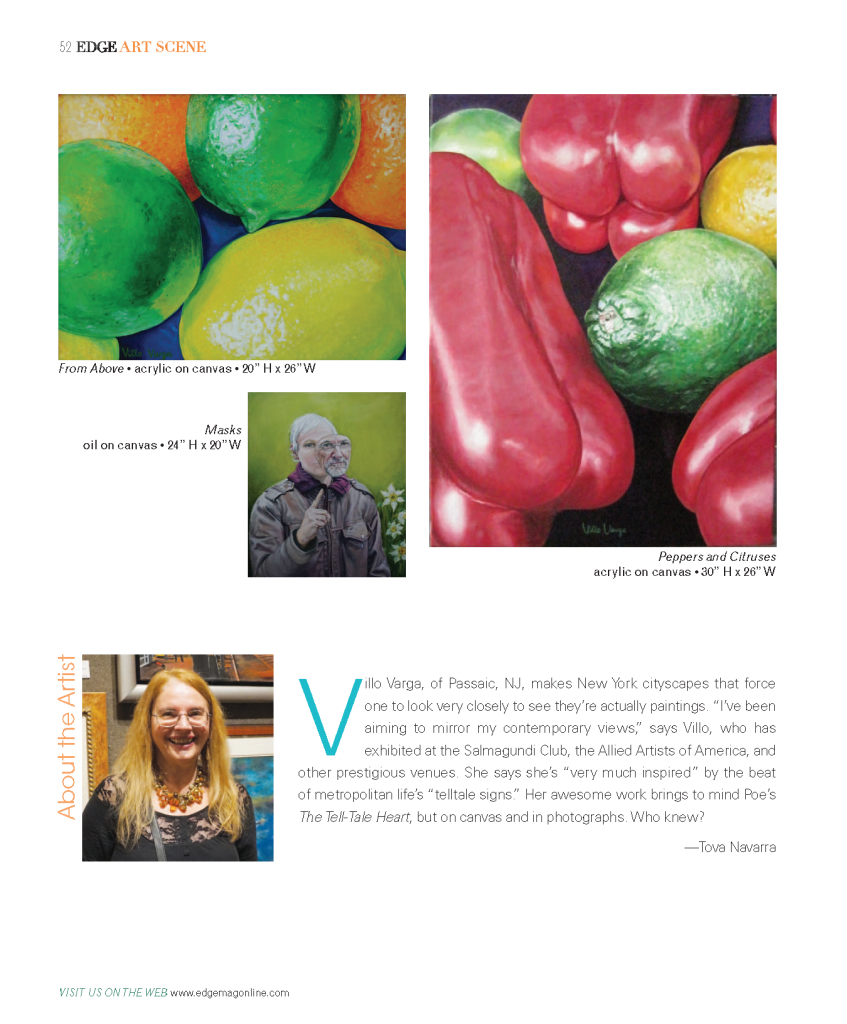
Villo Varga, of Passaic, NJ, makes New York cityscapes that force one to look very closely to see they’re actually paintings. “I’ve been aiming to mirror my contemporary views,” says Villo, who has exhibited at the Salmagundi Club, the Allied Artists of America, and other prestigious venues. She says she’s “very much inspired” by the beat of metropolitan life’s “telltale signs.” Her awesome work brings to mind Poe’s The Tell-Tale Heart, but on canvas and in photographs. Who knew?
—Tova Navarra
Buzzing Under the Radar
In this year of vaccine hyper-awareness, the first-ever vaccine against the deadliest of all human parasites has gone almost unnoticed.
By Mark Stewart
 Over the past year, chances are that you have heard more facts and figures about vaccines than in all of the other years of your lifetime combined. Yet while we have all become intimately familiar with the COVID-19 vaccine, there is another vaccine on the market, which—in any other year—would have been the real headline-maker. Last year, the World Health Organization (WHO) announced that it had approved use of the first-ever vaccine that is effective against malaria, a mosquito-borne disease that can kill within 24 hours of its flu-like symptoms appearing.
Over the past year, chances are that you have heard more facts and figures about vaccines than in all of the other years of your lifetime combined. Yet while we have all become intimately familiar with the COVID-19 vaccine, there is another vaccine on the market, which—in any other year—would have been the real headline-maker. Last year, the World Health Organization (WHO) announced that it had approved use of the first-ever vaccine that is effective against malaria, a mosquito-borne disease that can kill within 24 hours of its flu-like symptoms appearing.
“Malaria vaccines have been in development since the 1960s,” says Dr. William E. Farrer, Chief of Infectious Diseases at Trinitas (left). “On October 6, WHO released a recommendation for widespread use of the RTS,S/AS01 malaria vaccine among children living in sub-Saharan Africa and other regions with moderate to high P. falciparum malaria transmission.”
Plasmodium falciparum is the parasite that transmits falciparum malaria, the deadliest form of the disease, which accounts for roughly 50% of cases worldwide and virtually all malarial deaths. For the record, that makes P. falciparum the deadliest of all human parasites. “The vaccine requires three primary shots and a booster,” Dr. Farrer explains. “In large trials, it decreased clinical and severe malaria by about 30%. This is only moderate efficacy, but represents a historic step forward in controlling malaria and could prevent many cases of this dread disease and many deaths.”
Dr. Tedros Adhanom Ghebreyesus, WHO Director General, also described it as a historic moment, predicting it would prevent thousands of deaths a year. Currently, malaria is estimated to kill more than a quarter-million young people annually and over 400,000 in all (estimates fluctuate wildly depending on the source, but the numbers are undeniably huge). Even when it does not kill, malaria can return to sicken the same person several times over the course of a lifetime, or even in the same year—devastating the immune system over time, which makes it vulnerable to other diseases.
 The new vaccine, which has been recommended for children five years old and younger, marks a significant step in an effort to conquer malaria that has seen worldwide deaths drop by 60% in the last two decades, and the number of cases cut nearly in half. Unfortunately, progress reached a kind of plateau around 2015 and the numbers have remained more or less constant since then. The recent breakthrough, which activates the immune system to battle the malaria pathogen, owes much to the work done in speeding COVID vaccines to market.
The new vaccine, which has been recommended for children five years old and younger, marks a significant step in an effort to conquer malaria that has seen worldwide deaths drop by 60% in the last two decades, and the number of cases cut nearly in half. Unfortunately, progress reached a kind of plateau around 2015 and the numbers have remained more or less constant since then. The recent breakthrough, which activates the immune system to battle the malaria pathogen, owes much to the work done in speeding COVID vaccines to market.
That being said, malaria is not caused by a virus, like COVID, nor by bacteria. Malaria is spread through a parasite which has over 5,000 genes, as opposed to SARS-CoV-2, which has only 11. That is a major reason why malaria has been so good at befuddling vaccine researchers. Indeed, the new RTS,S vaccine will still need to be combined with conventional malaria-prevention strategies—insecticides, netting and artemisinin-based drug therapies—in order to be fully effective. Artemisinin, discovered in 1972, is extracted from sweet wormwood, a plant used in traditional Chinese medicine; it earned the woman who discovered the breakthrough medicine, Tu Youyou, a Nobel Prize. The maddening aspect of fighting malaria is that a vaccine series must target the parasite at all of the different stages of its life cycle. The idea is to “get it” at one stage if it “misses it” at another, with the goal being to kill the parasite before it infects the liver.
 Impact on the Home Front
Impact on the Home Front
Does the malaria vaccine have any relevance here in New Jersey? Absolutely. More than 2,000 malaria cases are reported in the United States each year, the vast majority coming from Americans vacationing in tropical countries or returning to their countries of origin to visit friends and family. Malaria can be transmitted to a fetus by its mother when bitten by a mosquito carrying the disease, resulting in low birth weight or premature delivery, as well as other more serious (and potentially deadly) health problems to a newborn.
The number of reported cases in Western Hemisphere nations with strong ties to the Garden State—including Mexico, Brazil, Colombia, the Dominican Republic, Nicaragua and Haiti—top 5 million annually. That pales in comparison to India, which recently topped 100 million cases. Vietnam and Indonesia may have more than an estimated half-billion cases in a typical year.
Humans and mosquitoes both thrive near water, and thus have lived together for countless thousands of years—so long, in fact, that this relationship has “imprinted” itself on our genome. The origin of sickle cell anemia, for instance, is a genetic variation that very likely began as a result of malaria. Most people develop antibodies against malaria by the time they reach adulthood, but it takes a grim toll on children, particularly in Africa, where more than 90% of the world’s cases are recorded. The new vaccine completed its first trial run from 2019 to 2021 in Ghana, Kenya and Malawi. It proved particularly effective against Plasmodium falciparum—as mentioned earlier, the deadliest malaria parasite (there are five in all).

www.istockphoto.com
Perhaps because humans and mosquitoes share an evolutionary history, the disease has shown an ability to mutate in response to everything we’ve done to fight it. It is anticipating the next mutation (and the next and the next and the next) that also proved challenging to the development of an effective vaccine. An example of this is the discovery in 2019 of a malarial strain that is resistant to Artemisinin. The mutation took place in Africa instead of Southeast Asia (where malaria mutations typically take place), further raising concerns because the parasite would have mutated independently to resist treatment.
A First Step, But Hardly the Last
The new RTS,S vaccine is not the be-all end-all in the fight against malaria, as Dr. Farrer pointed out. The 30% effectiveness number has drawn criticism from those who would wait for a more effective vaccine before launching the ambitious four-dose campaign in some of the world’s most remote, at-risk regions. However, it is an enormously encouraging first step upon which better vaccines can be built. The mRNA technology wielded against COVID, for instance, holds huge promise in this regard.

www.istockphoto.com
The new vaccine, which goes by the brand name Mosquirix, is the culmination of a research and development partnership, spearheaded by the pharmaceutical giant GlaxoSmithKline, that began in 1987. In recent years, it has been funded by the Bill & Melinda Gates Foundation, among others. In addition to being the first malaria vaccine, Mosquirix holds the distinction of being the first-ever vaccine for any parasitic disease.








